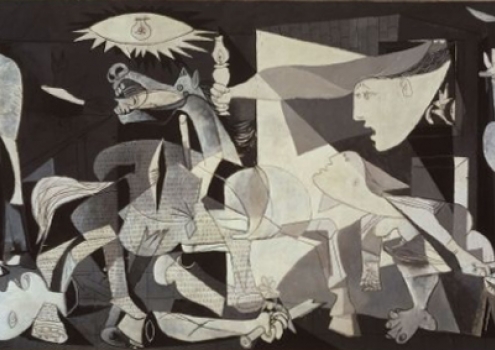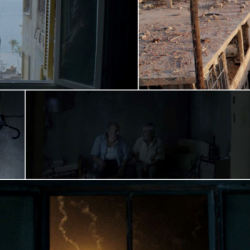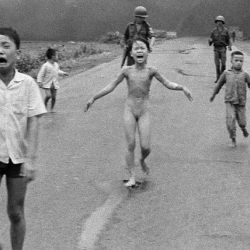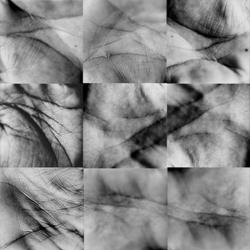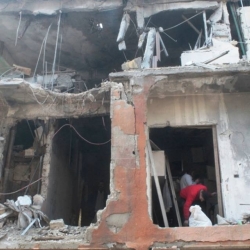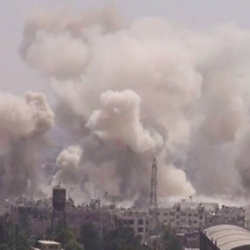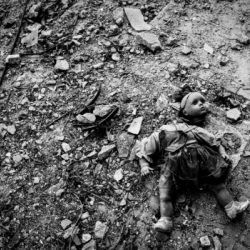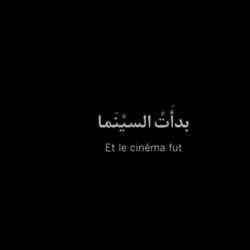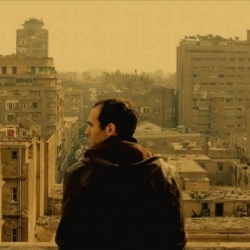“The icon of the Syrian diaspora: On the picture of the drowned child, Aylan
01/10/2015
Author: Alaa Rashidi
In the digital information age, examining this image (which constituted a major humanitarian event the minute it was released) is an attempt to analyse the image’s relationship with the social reality of a given group of people, with political events, and to understand the potential trajectories of the image within the media, while avoiding the dictates of the fast news cycle and the emotionalism of immediate response. The photograph of Aylan, the drowned child, was first released on September 2 and it continues to appear in various contexts. The latest issue of the Islamic State’s Dabiq magazine, which is also available in English, published the picture of the Kurdish child beneath the headline, “The dangers of leaving the lands of Islam,” even as the Arab press was accusing Charlie Hebdo of flagrantly misusing the image and mocking Muslim children.
Images of children for every stage of the Syrian conflict
Ever since the children of Deraa first came to attention in March 2011, every stage of the Syrian conflict has generated its own iconography of images associated with children. The picture of Hamza Al Khatib ushered in awareness of torture in regime prisons and detention centers, while Zeinab Al Hosny became a tragic symbol of the media-mediated war of Syria’s competing political discourses. And now, the picture of Aylan has become the visual icon of the phase that Syrian society is currently passing through, and which international aid organizations have dubbed the biggest refugee movement since the Second World War.
The story behind the image
The image of the drowned boy can be seen as the last scene in a story, or the last frame in a film, about a family of Syrian Kurds who decided to flee the country. Since the day he was born three years before, Aylan had never known stability in a safe zone.
His family moved from Kobani in northern Syria to the capital, Damascus, then on to Aleppo where, due to the deteriorating security situation, they relocated to Turkey for the first time. Subsequently, they decided to come back to Kobani, the town to which the world has only recently turned its attention when it was liberated from the clutches of the Islamic State. For two days in June the jihadists carried out a massacre there until they were finally thrown out by Kurdish fighters. Around two hundred Kurds were slaughtered in this massacre.
Back to Turkey, whose camps were unable to accommodate Aylan’s family. They spent a month in Bodrum where their first two attempts to cross to Greece came to nothing, while the third ended with their boat capsizing on its way to Kos and twelve of the Syrian refugees drowning, among them Aylan (three years old), his brother Ghaleb (five years old), and their mother. On September 2, 2015, the world woke to find their bodies on the beaches of Bodrum.
This is the story, which represents a cross-section of the suffering experienced by any Syrian family: civil violence, barrel-bombing by regime forces, religious extremism, economic deprivation—living conditions that push one into an exile that is essentially a journey to death. Aylan’s picture is the icon of Syria’s refugees.
Europe accused of drowning a Syrian child
The image of the drowned child prompted much blaming over the death of a three year-old who’d tried to cross the sea to find a better life, but there was confusion over who exactly was to blame and the political logic that lay behind the occurrence of this terrible crime.
Who was the accused? The picture showed a victim but no criminal.
Was it the father, who tried to get a better life for his children? Was it the smuggler, whose boats were not equipped to transport so many people? Or the Islamic State and the jihadists, who’d committed the massacres in Kobani? Or Bashar Al Assad’s regime, which bombed and shelled villages and rural towns?
Such facts were known before, but when the picture of Aylan came out a new scapegoat was added to the list: Europe.
The shot of the dead boy on the Turkish beach filled the front pages of Europe’s newspapers and magazines. The next day the French paper Liberation had to issue an apology for its editorial team having failed to appreciate the significance of the image and not publishing it.
It was the first of all the thousands of images of Syrian children produced since 2011 to directly impact Europe. In other words: Europe stood accused for the first time by the picture of a drowned Syrian child. Reading and interpretations proliferated: the image was a symbol of European hatred of refugees, a hatred enshrined in its laws and mechanisms. Whatever impact the image had, ran the argument, it should be used to foreground and encourage the popular support and welcome shown by European and Mediterranean countries and bolster extant laws to protect the rights of refugees.
The image’s impact: between romanticism and effectiveness
As for the moment when the news of the dead child first broke, many people wondered whether a single image is capable of altering international positions and policies in such a way as to bring an end to the terrible fate plaguing this society on the shores of the Mediterranean. Or would it do no more than stir individual emotions and sympathies?
Dreamers liked to dream of the moral impact the picture would have on international relations and the situation in Syria, or on the refugee crisis. They voiced their criticisms in Utopian terms and asked the poor picture to do the job that all the dead and wounded reported on the daily news for five years straight had failed to do: reports that talked of nearly a quarter million dead, of twelve million displaced.
Aylan’s image might make the prime minister of Sweden cry and sadden Erdogan, it might wake European politics from its slumber, but it is incapable of effecting change. Today, more than twenty days after its first release, it is possible to appreciate the image’s capacity to relate human experience, to communicate and embody the social moment, and yet no matter how charged with moral guilt, it is not in and of itself capable of making change. If we assume so, we will have burdened it with more than it can handle and, with our romantic idealism, have lost it forever.
Jean-Luc Godard said: “One cannot change what is in the image. Change is perhaps what happens between one image and the next.” The hope, then, is to focus on the sense of moral obligation that the image inspires in those who see it—EU officials, members of international humanitarian organizations, civil society groups and artists—pushing them to work seriously to improve political, social and economic relations between states on the fringe of the Mediterranean.
This is the hope we have when we hear European agencies describing Aylan’s picture as “painful” or “a picture which stirs the emotions.” From such dreamy phrases we hope will spring effective action to save the refugees, to help improve relations, and to bridge the gulf that separates national populations around the Mediterranean, but to do so makes us look once more like idealists and dreamers ourselves.
Furthermore, those whose voices are suppressed can brandish the image in the hope it will convince the international community of the need to find a solution to the situation in Syria, whether those who are demanding the Syrian regime continue in power or those for whom the image is a sign that the regime’s rule must be brought to an end. This is why the picture of the boy is a perfect symbol of this current historical moment: a drowned body with the power to relate the situation in Syria with such fidelity.
The media and the image: 1. manufacturing the image
Social scientist Andre Gunthert mentions that Aylan’s first appearance in the media was in a video, with the still photograph appearing later. The photograph was carried by a Turkish news agency, then picked up Reuters and AFP. The more exposure it got, the less was known about it.
Philosopher and writer Marie Jose Mondzain [1] states that, “whether or not the image was manufactured, it informs us about the social and economic conditions of a group of people we know, and with whom we share this sea. The image should prompt us to assist those who survive the journey as refugees and to join campaigns calling for a warm welcome to be given them.”
The media and the image: 2. the audience chooses what impact the image has
Mondzain [1] also speaks about the role of the audience in selecting the image that affects them: “Attempts by news agencies to manufacture an image never achieve the desired effect in a single image. Behind any image is the reality of social and economic conditions experienced by a group of people. This is a truth that predates the image. When news or visual media agencies decide to support a given issue or give their backing to another, they create visual content, image and videos connected to the issue. But the desired effect is never achieved by any one picture. Rather it is the viewer, the audience that plays a part in selecting them, which is why the images that affect us are ones we have selected ourselves, whose impact we have chosen.”
The media and the image: 3. the sacred image
In the September issue of Charlie Hebdo, in a piece entitled “Welcome to the refugees!” the editors of the satirical journal used the image of Aylan to criticize EU policy on refugees and the attitudes of Christian Europe, which cared nothing for the children of its Muslim neighbors. However the Arab press saw this as a deeply disrespectful violation of the sanctity of the small boy in the picture, particularly as Charlie Hebdo has a long history of printing cartoons provocative to the Muslim world, a history which led to the criminal operation targeting employees at the magazine.
In doing so the Arab press outlawed the use of the image for humanitarian ends, even to criticize the policies that had led to Aylan’s death, i.e.: EU policy towards Syrian refugees.
Final description of the image
The subject faceless. An eternal child.
They said that the picture of the drowned child reminded them of the massacre of the innocents, of the child on the edge of Guernica, Picasso’s 1937 rendering of the horrors of the Spanish civil war.
They said it was a picture of child turned upside down, a subject without a face. The photographer thought he was asleep.
They called him the innocent victim, lying on the seashore one morning, the international symbol of our sleeping conscience.
They spoke of the iconic status of the child’s body, which is transmuted only into its own image, curled in on itself, wandering out of the composition’s field of vision, away from the life in which all Syrians remain.
Footnotes
[1] Quotes from the Interview of France Culture with Philosopher and writer Marie Jose Mondzain.
link to the interview: http://www.franceculture.fr/emission-la-grande-table-2eme-partie-une-image-peut-elle-changer-l-opinion-2015-09-08



